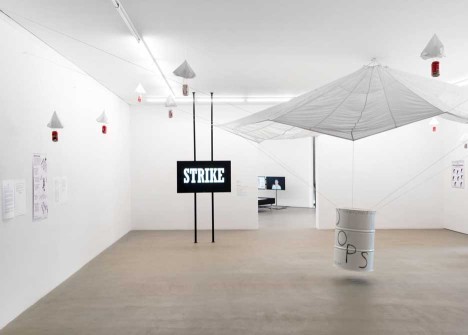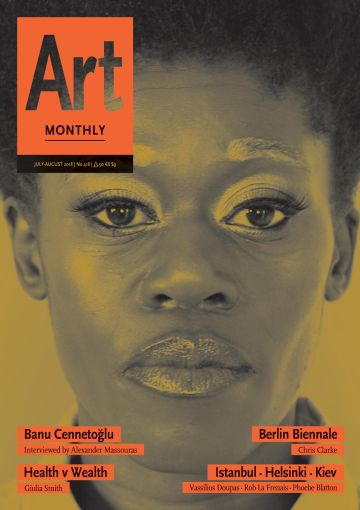Review
Martha Rosler and Hito Steyerl: War Games
Stephanie Schwartz reviews the two-artist show at Switzerland’s Kunstmuseum Basel

‘War Games’ installation view
Martha Rosler and Hito Steyerl’s ‘War Games’ opens with nothing much to see (Interviews AM314, AM375). On entering the gallery, viewers are confronted, quite literally, with Rosler’s Reading Hannah Arendt (Politically, for an American in the 21st Century), 2006, an installation of 16 transparent plastic curtains. Almost touching the floor and filling the space, the transparencies are printed with selections from Hannah Arendt’s 1951 book Origins of Totalitarianism. Viewers are tasked with reading through the sheets and confronting the faces of others who are also reading. Transparency and publicity usher into view the obfuscations organising totalitarianism, then and now. After all, Arendt’s insistence that ‘never has our future been more unpredictable’ still defines our sense of time.
This time period also frames the other work on view in the exhibition’s first room: Steyerl’s Babenhausen 1997, 1997. The four-minute video combines footage of the burnt-out home of the town’s last Jewish resident with a speech, recorded at an Antifa demonstration, confirming that Babenhausen has, once again, been ‘cleansed’ of Jews. The past is never past, Babenhausen makes plain. It repeats, like the recorded speech, confirming, as the recording does, that ‘no speech will be acceptable to give an account of what happened here’.
The conceit of representation’s inadequacies is, viewers encounter over and over in this exhibition, the ‘game of war’. This is made evident by the work which gives this conceit its most famous platform and (art) history: Rosler’s The Bowery in two inadequate descriptive systems, 1974-75. Exhibited alongside OOPS! (Nobody Loves a Hegemony), 1999, Rosler’s account of the way in which what became known as the Kosovo war was played out through a few iconic photographs and far too many words, the 24 panels making up The Bowery now read as a work about the war in Vietnam. The dead soldiers and dead marines not pictured in the frames become news. They become the droning verbiage making up the soundtrack of everyday life heard on the television in Rosler’s Domination and the Everyday, 1978. On that screen, the work of representation doesn’t begin with a blank or blackout, as in The Bowery, but with the techno-colour television test pattern. More than just a reference to the break between programming, this pattern sets off – screens – the US wars that are taking place elsewhere – in Vietnam and Chile – as entertainment.
Seeing what is not seen is the punchline of Steyerl’s Is the Museum a Battlefield, 2013, a double-screen installation featuring a video of a lecture Steyerl gave on the occasion of the 13th Istanbul Biennale. Designed to advance her claim that the museum is, has always been, a field of war, Steyerl’s lecture traces the origins of bullets fired in Turkey, which killed her friend Andrea Wolf, back to the organisation funding the Art Institute of Chicago, where Abstract, 2012, a work about Wolf’s death, is exhibited. The bullets’ trajectory is played out through a series of screens: the ones before viewers of the exhibition, before spectators at the lecture, on the phone recording the bullets in Turkey etc. These mediations also frame the bullet that Steyerl holds up for her audience, which, as she acknowledges with a smirk, is not ‘there’, cannot be seen. This critique of institutions does not make visible the trajectories of power that are made not to be seen in the museum and elsewhere; rather, it overwhelms those looking or searching with seeing. As is the case with many of the works on view in ‘War Games’, including The Bowery, representation is not inadequate; indeed, viewers see or are shown too much. There is too much news, too much information. There are too many screens. In Duty Free Art, 2015, another of Steyerl’s lecture videos, the information being ‘disclosed’ is already out there among the morass of data on the web – it is already known.
The exhibition’s gambit is played out most brilliantly through its form: collaboration. ‘War Games’ refuses the art-historical conceit of legacy. There is no sense here that the older artist sets the stage for the younger artist. Lineages and influences reverse and overlap, refusing to offer the individual artist as ‘the screen’ through which war’s stories could be told, even though, for both artists, ‘the artist’ – the female artist – is very present. For both, though, this presence is always mediated – a recorded voice, a lecture that was already given, staged or seen. Both Rosler and Steyerl play and perform their representations through their engagements with technology. This is why the generational story would never have worked. It rides too close to technological determinism, to the claim that technologies drive history. Despite the evident technological distance between then and now on view in the exhibition, the same war is still being fought on the screen. Instead of colonising the moon, the subject of Rosler’s ‘House Beautiful: The Colonies’, 1966-72, Mars is the current destination. Nothing repeats in the modern game of war, it is simply still happening. There is, as Rosler insisted with ‘House Beautiful: Bringing Home the War’, 2004-08, a new series.
‘War Games’ reminds its viewers that writing new histories requires wading through the repetitions – or playing the game. This point is made ever so subtly in Steyerl’s Hell Yeah We Fuck Die, 2016. Taking as its title the five words occurring most frequently in English-language pop lyrics over the past decade, the multimedia installation includes Robots Today, an eight-minute video which tells a story that couldn’t be told – or that Siri is unable to tell – of the 12th-century Anatolian engineer, Al-Jazari, who is considered one of the first people to have invented programmable devices. History is written with the information that is made public, over and over again, until it becomes standard – ‘hell’, ‘yeah’, ‘die’ etc. This writing is the training game, the preparation for the war that, as Arendt suggested, is always yet to come. Too much information does overwhelm, screen out war, but it also, as ‘War Games’ instructs, makes the writing of other war stories possible.
Martha Rosler and Hito Steyerl: War Games is at Kunstmuseum Basel 5 May to 2 December 2018.
Stephanie Schwartz is lecturer in history of art at University College London.
First published in Art Monthly 418: Jul-Aug 2018.










